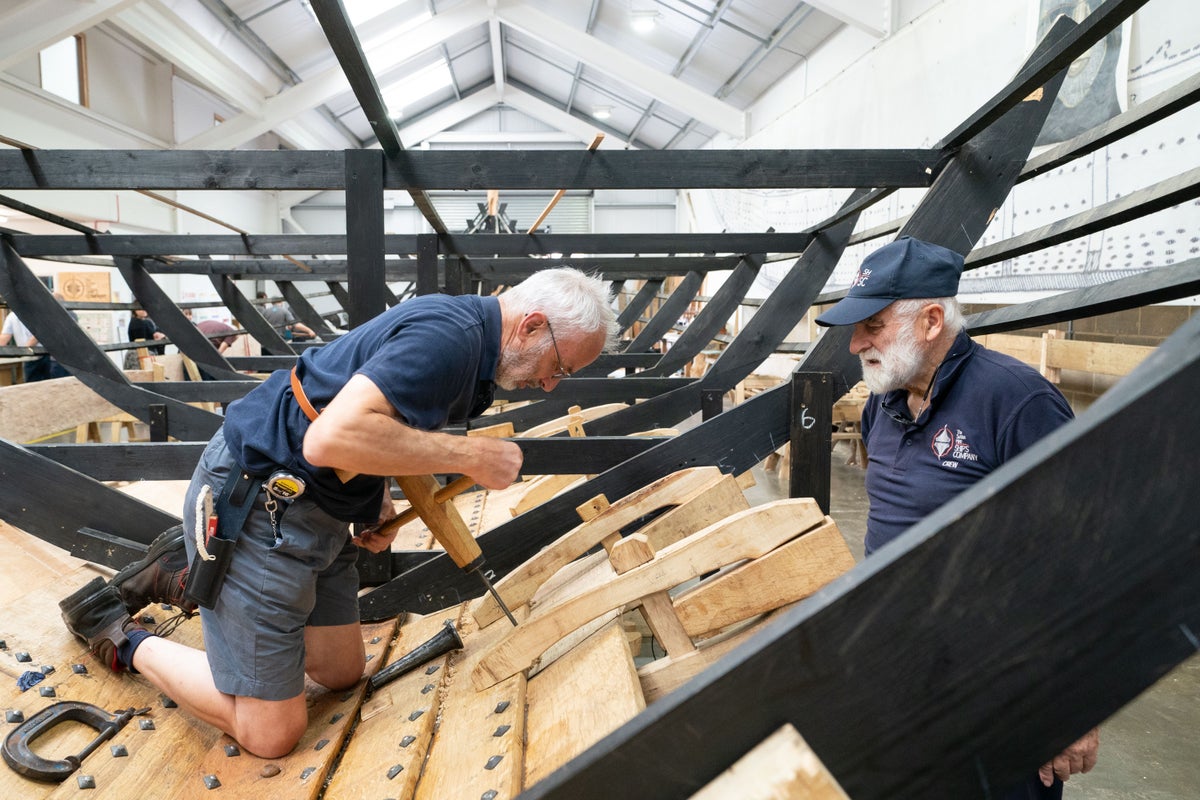
The backbone of an 88ft-long replica of the Sutton Hoo longship has been completed, after a nine-month delay when one of the first wooden pieces split.
The full-size reconstruction of the Saxon ship that was excavated in 1939 is being built by a team of around 120 volunteers in a shed beside the River Deben in Woodbridge, Suffolk.
Independent charity the Sutton Hoo Ship’s Company, which is building the ship, has been funded by donations.
The project’s master shipwright, Tim Kirk, said most of the volunteers are retired – including retired engineers, social workers and an eye surgeon.
This week they were joined by three National Trust apprentice joiners, and Mr Kirk said they have also been helped by the Royal Engineers from the nearby Rock Barracks.
Dating from the early 7th century, the original Sutton Hoo longship has been described as a ghost ship, as its timber had rotted away in the acidic soil, leaving only an imprint in the sand.
Around a third of the planks of the replica ship – 36 pieces – have now been fastened on, with the remaining 60 to 70 planks expected to be in place by the end of the year.
Mr Kirk said each plank takes around 40 hours to work down from a wedge of timber cleaved out of a log, with each section up to 5.5 metres (18ft) long and weighing 300 to 400lbs.
It then takes a further 20 hours to make the plank the right shape and fasten it to the ship.
The ribs of the ship, made of oak and secured with iron rivets, will start to be added further into work on the planking.
Mr Kirk said the backbone of the ship was completed in November of last year, a year after the first two finished pieces were joined together.
But the project was delayed by some nine months when one of these first pieces split.
“The first piece that we secured, unfortunately it split, which is one of the hazards of using green timber – freshly sawn, unseasoned timber,” said Mr Kirk.
“That set us back as we had to go and source another tree that was exactly the same shape as the one we had before.”
He said it took around six months to find a suitable tree, after a period of consultation on what to do about the split piece, then some 450 man hours to craft the new piece from the tree.
Mr Kirk said it had been “really difficult to get the size of timber that we need” and is seeking at least three logs that are six metres (20ft) long and 1.2 metres (4ft) in diameter.
“We’re looking for really big special trees and there are not as many about in Britain today and even fewer in East Anglia,” he said.
“It looks like we’ll have to go outside of the region and look nationally, and I’m hoping we don’t have to go and look internationally but it may be that we have to do that which would, of course, add significant cost to the project.”
He hopes the ship will be completed and be ready to be tested on the water by spring of 2025.
One of the National Trust apprentice joiners, Josh Bobbett, who usually works on windows, doors and gates at stately homes, said it was a “once-in-a-lifetime thing” to work on the longship.
Mr Bobbett, 32, from Shrewsbury, said: “It’s like nothing I’ve ever done before.
“You’ve only got to look at it, really.
“Almost 90ft of oak timber, all hand planed with axes, it’s a bit unusual.”
He added: “The biggest thing I’ve learned really is a bit more about woodgrain, imperfections and how they can completely ruin your day if they aren’t going your way.
“I’ve got a new appreciation for that.”
It is hoped that, following the £1 million project, the longship will become a tourist attraction.







